Aha! Roadmaps | How to set product strategy
Every product team is unique. But most share a universal understanding — winning plans start with strategy. You want that strategy to be customer and market-driven, while also supporting higher-level business objectives. Establishing your product strategy upfront sets the foundation for building products that people love and for your team to enjoy working together.
The challenge and tension usually comes from choosing what to prioritize and when. Most product managers have more ideas and feature requests than they can possibly deliver. You need to apply goal-first, strategic thinking to your product planning process — so that the entire organization can focus on creating the most value.
Making room for strategic thinking is tough when you are consumed with daily product management work. Cross-functional meetings, responding to customer requests, prioritizing ideas — all before lunch.
Organizational leaders often change their minds. Priorities shift. This intensifies the tedium of maintaining scattered spreadsheets, presentations, and documents that contain elements of your strategy. And yet, to achieve something great, you need to put strategy at the center of every product decision you make. We know this pain well.
Our team at Aha! has deep product management experience. We work closely with product teams from some of the world’s largest and most sophisticated technology companies. And so we know that the process for setting product strategy varies from company to company — impacted by factors like the maturity of your product, the size of your company, and the structure of your product management organization.
But we also know that there are best practices we can share from those experiences. We created the steps below to help you understand how to use Aha! Roadmaps to set high-level product strategy and quickly turn it into a visual strategic roadmap to share with your team. Click on any of the links below to read instructions on how to use the specific functionality referenced.
Start with the essentials
Start by thinking about where you want to take your product. What problem are you trying to solve? What do you want to achieve? Consider your vision, strategic model, and product positioning. This is the foundation for setting strategic imperatives (like goals and initiatives) which will help get you closer to achieving your vision.
Capture your vision
Vision represents the core essence of your product. Your vision statement sets the direction for the future. The statement should be a short, simple declaration of the future state of your product. For example, in Fredwin Cycling (the example product included in Aha! Roadmaps as a demo) the vision statement is:
The #1 social fitness cycling application
Use the strategic vision in Aha! Roadmaps to capture and organize supporting elements. You might add your company’s mission and/or details about your current market environment — these components will be helpful as you begin to set the rest of your strategy.
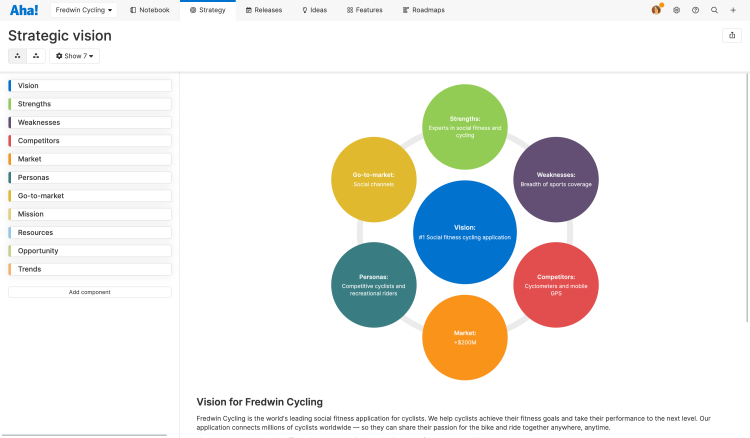
Examine your business model
Now you will want to evaluate your business model. This represents the framework of your business in distilled and simple terms — it details how your products will create value in the market and the environmental pressures that you face.
We recommend starting with a business model template and customizing it as needed. Our team curated a set of the industry’s most effective strategic model templates to include in our software, including SWOT analysis, Lean Canvas, and a specially-designed Aha! business model canvas informed by decades of product and company building experience.
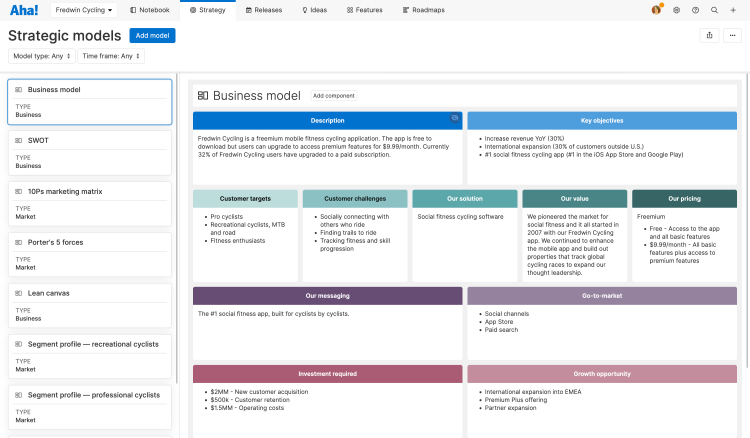
Define your product positioning
Product positioning helps you explain how you will succeed in the market by describing the unique strengths of your product and the challenges that your customers face. To position your product, you need to know what is important to your customers and the problems your product can solve.
Once you feel confident that you understand those pain points, create your product positioning to help your organization understand where your product fits. (We have a product positioning template to get you started.)
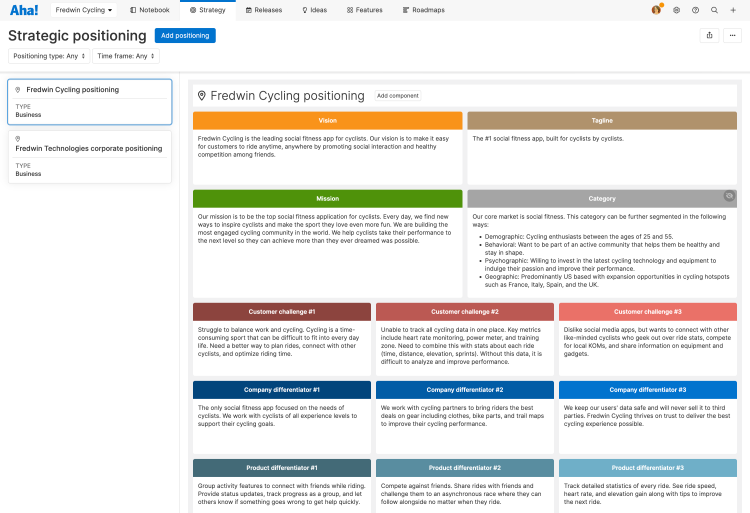
Document market forces
You know who your customers are, what they care about, and what other products they can choose from to address their problems. And you know why your product is the better choice too. Strategic product decisions require a robust, well-documented understanding of the marketplace. Now it is time to document it.
Create your user personas
User personas are fictional representations of the types of people that use your product. Personas contain critical background information on the skill levels, experiences, and preferences of your users — so your team can build lovable experiences.
Start by creating a user persona for each of the key types of people who use or influence the purchase of your product. Later, you will be able to share these personas by linking them to records (such as features, epics, and releases) so everyone on the team knows who will be using your next enhancement.
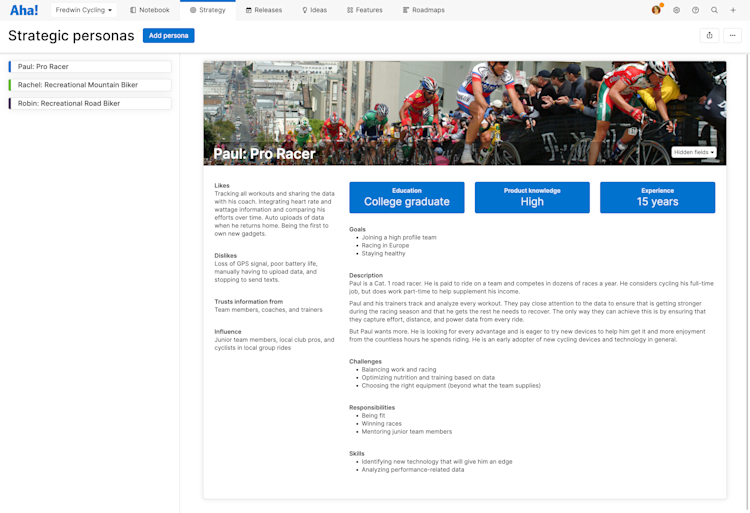
Analyze your competitors
In many companies, competitive information is scattered — at best in emails and documents. At worst, in conversations and within the minds of experienced team members. To understand your advantages and opportunities in the market, you want to document a competitive analysis.
Competitor profiles should include key details like the company’s mission, size, strengths, and weaknesses. Compare each one using a grid view and show where your product fits in comparison.
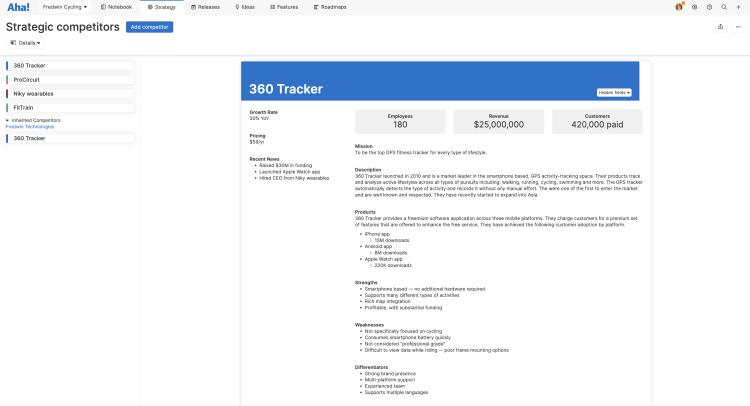
Define strategic imperatives
We have a saying at Aha! — “goal first.” It is part of The Responsive Method and baked into our company’s DNA. And it can be part of yours too. The first step is to set goals and define initiatives that actually make an impact on the business.
Set goals
Product goals help you define what you want to accomplish. They are the specific achievements that will move you incrementally closer to realizing your vision. Once defined, you can ensure that your goals are aligned to broader company objectives by associating them with higher-level goals that are set at the product line.
Goals should be measurable and time-bound. This is why every goal in Aha! Roadmaps needs a success metric and a time frame. Here is a quick example from our demo company:
Goal: Grow revenue for Fredwin Cycling
Success metric: +35%
Time frame: 2020 Q2
To ensure that your goals are aligned to higher-level business objectives, link them to higher-level goals that are set at the product line.
Establish a list of goals that you intend to accomplish in the next six to 12 months. Next, share the list with stakeholders and the rest of the team — get feedback and enter the final data into Aha! Roadmaps to track progress on your goals.
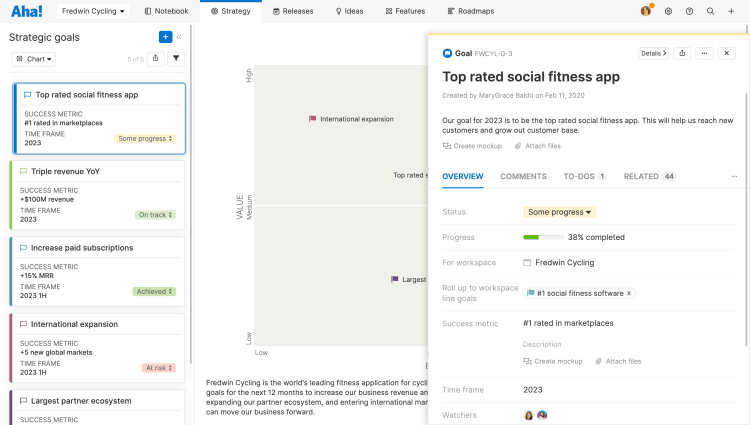
Define initiatives
Okay, goals are set. What is next? Initiatives represent the large efforts or themes of work that you will do to make progress on your goals.
Here are a few examples of initiatives:
Expand integrations
Create a partner portal
Refresh mobile application
You can connect your product initiatives to the rest of your strategy by creating a roll-up relationship to higher-level initiatives that are set at the product line. You can also link initiatives to goals so you can visualize all the work that will go into accomplishing each goal in your product strategy.

Visualize your strategy with a roadmap
Your strategic roadmap visually represents where your product is headed and what you want to achieve. To get everyone thinking the same way, share your roadmap with your executive team, your engineering leaders, and your functional leads. When they know your strategy, they can prepare their own plans to support it.
Create a strategy roadmap
Start by choosing Strategy in the Roadmaps section. Create a new roadmap and select the initiatives, releases, epics, and features that you would like to display. The strategy roadmap has a variable time frame that provides flexibility (day, week, month, or quarter) in how you present your plans, so you can tailor the view to your audience.
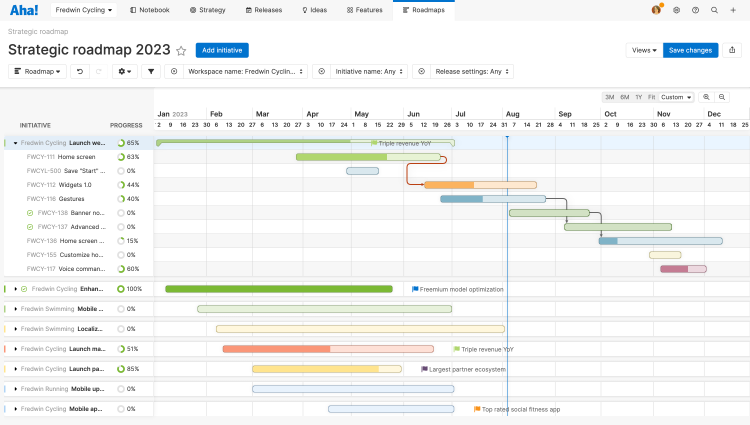
Create a presentation
Bring your strategy together with an Aha! Roadmaps presentation. Presentations are always updated with the latest changes. When you update a record or report in Aha! Roadmaps, the presentation will automatically update with the latest changes — or if you prefer, you can configure the update frequency for each slide.
Yes, you read that right. You no longer need to maintain multiple versions of your roadmaps and presentations. They are always up to date.
Creating a presentation is simple. Add any page from Aha! Roadmaps to a presentation using the Add to presentation option. The option will create a slide in a new or existing presentation. Or if you prefer, you can start with a blank canvas and customize it.
Then build your presentation. Rearrange or copy slides and customize with text, whiteboards, and images that illustrate your plans and demonstrate your key points.

Share it
Now that you have built your strategy, time to share it with the team. You have several options for presenting your strategy. From your Aha! Roadmaps account, you can:
Share your presentation as a secure webpage. This will create a secure URL that is always updated with the latest data in Aha! Roadmaps and can be accessed by your audience at any time.
Use the Present option if you are presenting directly to your teammates.
Publish and share your presentation by generating a PDF.
When you share your presentations as a secure URL, the presentation can be accessed by anyone who has the URL. To keep your presntation URL secure, you can restrict access by requiring a password to access your presentation, by limiting access to only Aha! Roadmaps users, or both.
Strategy matters
No one ever seems to have the time to do the hard work of thinking about the vision of a product, the goals and initiatives that will get you there — but it is absolutely essential. And it should come first.
So what comes next? Start tracking progress by connecting strategic imperatives to your features, epics, and releases. And make the time to update your strategy regularly as customer and market conditions change.
But most importantly, share it. By making your strategy easily accessible, you can align your teams so everyone moves in the same direction, towards what matters most. And hopefully, have a bit of fun in the process.